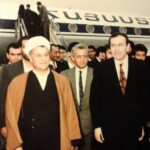In the kaza of Manazgerd, in the northeastern part of the sancak of Mush, comprising 39 Armenian villages with a total Christian population of 11,930, conscription spawned acts of extreme violence, as it did in other areas as well.
According to an Armenian witness, men between the ages of 18 and 35 were inducted into combat units, while those between the ages of 35 and 50 were assigned to transport units; most of the latter were killed by Kurdish çetes upon their return from the front.
Arms were collected in Manazgerd as early as mid-April, which led to only limited violence. It was also in this period that the Turkish army beat a hasty retreat under pressure from the Russian forces, which had advanced as far as Tutak, in the northeastern part of Melazkırt.
The army systematically plundered Armenian villages as it withdrew, while incorporating an average of 30 to 40 men in each village.
Guided by the kaymakam Halet Beg and two hamidiye officers, Sarti Beg and Süleyman Beg, the army methodically looted the following villages:
Noradin (pop. 1,671; 70 people were killed),
Kharaba-Khasmig (pop. 234; 20 killed),
Erzaghi-Khasmig (pop. 663),
Sultanlu (pop. 116),
Molla-Mustafa (pop. 217; 20 killed),
Kotanlı (pop. 400; 20 killed),
Terig/Gereg (pop. 922),
Khanoghli (pop. 234),
Rsdamgedig (pop. 1,800; 30 killed),
Tundras (pop. 171),
Agner Sheytanava (pop. 421),
Pert/Manazgerd (pop. 945),
Ekmal (pop. 160),
Aynakhoja/Eknakhoja (pop. 360),
Oghzkhan/Okhkin (pop. 90),
Mollapagh (pop. 110; 10 killed),
Karakaya (pop. 725),
Marmus (pop. 300; 20 killed),
Dolazbash (pop. 300),
Pakran (pop. 155) and
Panzden (pop. 237; 30 killed).
Those killed in these villages were the young men still living in them – as a rule, adolescents. They were “recruited” by the commander of the hamidiye çetes, Haci Hamdi Beg, offi cially in order to carry out military transport. Conducted under guard to a place near Kotanlı, in the valley of the Murad Su, they were, on the testimony of a few survivors, shot and thrown into the river.
One hundred families from the administrative seat of the kaza, Pert/Melazkırt, together with 250 from the villages mentioned above, were grouped together in Agner by two Kurdish chieftains, İbrahim Beg’s sons Abdüllah and Hüseyin, who protected them from harm.
They fled to Alexandropol in the Caucasus when the Russian forces took control of the region in May; so did the Armenians from the villages of
Hasse (pop. 72),
Gushdian (pop. 52),
Hasan Pasha (pop. 47),
Ganigor (pop. 54),
Dugnug (pop. 438),
Endris (pop. 105),
Kharali (pop. 58),
Yaramish (pop. 73),
Sardavud (pop. 49),
Premasian (pop. 27),
Hajipot (pop. 79),
Khanek (pop. 51),
Keranlegh/Kirali (pop. 82),
Mkhchin (pop. 145),
Khoshajin (pop. 43),
Poyi-Chabghun (pop. 57), and
Dorokhan (pop. 268).
To be continued
Note- this chapter is from Raymond Kévorkian’s book ARMENIAN GENOCIDE: A Complete History.











